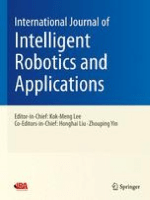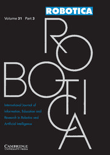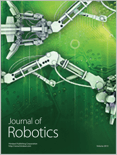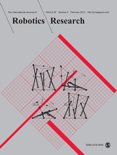
Robotics
Scope & Guideline
Connecting Minds for a Robotic Revolution
Introduction
Aims and Scopes
- Robot Learning and Adaptation:
Research focusing on machine learning techniques for robots, including reinforcement learning, imitation learning, and adaptive control strategies to enhance robot capabilities in dynamic environments. - Human-Robot Interaction (HRI):
Exploration of the interactions between robots and humans, emphasizing social robots, communication strategies, and the psychological aspects of robot acceptance and trust. - Robot Control and Navigation:
Innovative control algorithms and navigation techniques for various robotic platforms, including mobile robots, aerial vehicles, and manipulators, often incorporating advanced methods such as SLAM, optimal control, and decentralized systems. - Soft Robotics and Bioinspired Design:
Development of soft robotic systems that mimic biological organisms, focusing on compliance, adaptability, and novel materials to enhance interaction with humans and the environment. - Collaborative Robotics:
Research on multi-robot systems and cooperative behaviors, addressing challenges in coordination, task allocation, and communication among heterogeneous robot teams. - Robotics in Healthcare and Rehabilitation:
Application of robotic systems in healthcare, including rehabilitation robots, assistive devices, and social robots aimed at improving patient outcomes and quality of life. - Robotic Perception and Sensing:
Studies on enhancing robot perception through advanced sensing technologies, including vision, tactile, and auditory systems, and their integration for improved situational awareness.
Trending and Emerging
- AI and Machine Learning in Robotics:
An increasing number of studies are integrating artificial intelligence and machine learning techniques into robotics for tasks such as perception, decision-making, and autonomous learning, enabling robots to adapt and improve over time. - Social and Emotional Robotics:
There is a growing focus on developing robots that can understand and respond to human emotions, enhancing their effectiveness in social interactions and caregiving applications. - Robotics in Autonomous Systems:
Research on autonomous systems, particularly in environments such as agriculture, disaster response, and healthcare, is gaining traction, emphasizing the need for robots to operate independently in complex, unstructured settings. - Multi-Agent Systems and Swarm Robotics:
Emerging research themes are exploring the coordination and cooperation of multiple robots working together as a swarm, focusing on decentralized control strategies and collective behavior. - Human-Centered Design in Robotics:
An emphasis on human-centered design principles in robotics is becoming more prevalent, ensuring that robots are designed with user needs and experiences in mind, particularly in assistive and healthcare applications. - Robotic Systems for Environmental Monitoring:
The use of robotics for environmental applications, such as monitoring ecosystems and managing resources, is trending, driven by the need for sustainable solutions to global challenges.
Declining or Waning
- Traditional Industrial Robotics:
Research dedicated to traditional industrial robots, such as fixed automation and assembly line robotics, has seen a decrease, possibly due to the rise of collaborative and flexible robotic systems that adapt to varying tasks. - Basic Autonomous Navigation:
The focus on basic autonomous navigation techniques, such as simple obstacle avoidance, has waned as more sophisticated approaches incorporating AI and machine learning take precedence. - Static Robot Systems:
Static or non-mobile robot systems, which once received considerable attention, are becoming less prominent as interest shifts towards mobile and versatile robots capable of operating in dynamic environments. - Single-Task Robots:
The research on single-task robots designed for specific applications is declining, as the industry moves towards multifunctional robots capable of performing a wider range of tasks. - Theoretical Robotics without Practical Applications:
Papers focusing solely on theoretical aspects of robotics without practical applications or implications are less common, reflecting a trend towards research that emphasizes real-world application and impact.
Similar Journals

Annual Review of Control Robotics and Autonomous Systems
Fostering Collaboration for Cutting-Edge Robotics ResearchAnnual Review of Control Robotics and Autonomous Systems, published by ANNUAL REVIEWS, is a premier, peer-reviewed journal dedicated to advancing the field of control, robotics, and autonomous systems. With its E-ISSN of 2573-5144, the journal is recognized for its high-caliber contributions, evidenced by its Q1 ranking in key categories, including Artificial Intelligence, Control and Systems Engineering, and Human-Computer Interaction. Spanning converged years from 2018 to 2024, it serves as an essential resource for researchers, professionals, and students who seek to stay abreast of the latest developments and methodologies impacting these rapidly evolving fields. The journal does not currently offer Open Access options, which enables it to maintain stringent quality control while ensuring that every issue is packed with scholarly articles that meet the highest academic standards. With a focus on interdisciplinary approaches and cutting-edge technologies, the Annual Review of Control Robotics and Autonomous Systems is poised as a critical voice for scholarly discourse, fostering innovation and collaboration in tackling complex challenges of the modern world.

INTERNATIONAL JOURNAL OF ROBOTICS & AUTOMATION
Unleashing Potential in Automation and AI.International Journal of Robotics & Automation is a premier academic journal published by ACTA PRESS, dedicated to advancing knowledge and applications in the dynamic fields of robotics, automation, and related engineering disciplines. With a history spanning from 1995 to 2024, this journal serves as a crucial platform for the dissemination of innovative research, offering valuable insights across various categories, including Artificial Intelligence, Control and Systems Engineering, and Mechanical Engineering. Although currently not open access, its rigorous peer-reviewed articles hold significance for researchers, professionals, and students alike, providing a solid foundation for advancements in technology and engineering methodologies. The journal's rankings in Scopus reflect its growing impact, particularly in niche areas of Modeling and Simulation and Software, highlighting the critical need for cutting-edge research and discussion in these developing fields. As the landscape of robotics and automation continues to evolve, this journal remains an essential resource for those seeking to contribute to and engage with the forefront of scholarly research.

Robotic Intelligence and Automation
Transforming Ideas into Intelligent Solutions.Robotic Intelligence and Automation is a pioneering academic journal dedicated to the exploration and advancement of knowledge within the realms of robotics, artificial intelligence, and automation technologies. Published by EMERALD GROUP PUBLISHING LTD in the United Kingdom, this journal serves as a critical platform for researchers, professionals, and students who strive to understand and innovate in these rapidly evolving fields. With an impressive visibility across multiple disciplines, it has achieved a respectable Q2 ranking in Computer Science Applications, Control and Systems Engineering, Electrical and Electronic Engineering, and Industrial and Manufacturing Engineering, while also being recognized in Q3 for Artificial Intelligence and Human-Computer Interaction. The journal boasts a comprehensive Open Access model, allowing broad dissemination of research findings, which is vital for fostering collaboration and learning within the scientific community. Researchers can look forward to contributing to a publication that not only addresses current challenges but also seeks to shape the future of intelligent automation and robotics.

International Journal of Intelligent Robotics and Applications
Innovating Intelligent Solutions for TomorrowInternational Journal of Intelligent Robotics and Applications, published by SPRINGER SINGAPORE PTE LTD, is a pivotal platform dedicated to advancing the field of robotics and artificial intelligence. With an ISSN of 2366-5971 and an E-ISSN of 2366-598X, this journal has established its presence since its inception in 2017, showcasing innovative research and applications up until 2024. The journal aims to foster interdisciplinary collaboration by publishing high-quality articles that cover a broad range of topics from foundational AI concepts to cutting-edge robotics technologies. It holds respectable rankings, positioned in the Q3 category of Artificial Intelligence and Q2 category of Computer Science Applications in the 2023 metrics, and is indexed in Scopus with notable rankings in both computer science disciplines. Although it follows a subscription model, the journal remains committed to facilitating access to groundbreaking research for its audience of researchers, professionals, and students, contributing to the ever-evolving landscape of intelligent robotics.

ROBOTICA
Unlocking the Future of Robotics and Artificial IntelligenceROBOTICA is a premier academic journal that serves as a vital resource within the multidisciplinary field of robotics and artificial intelligence. Published by Cambridge University Press, this journal boasts a comprehensive scope that encompasses areas such as computational mechanics, computer vision, control systems, and software applications. With an impressive range of quartile rankings in 2023, including Q2 in key categories like Computational Mechanics and Control and Optimization, ROBOTICA represents a significant contribution to its field, providing researchers and practitioners with cutting-edge insights and advancements. Although it follows a traditional subscription model, the journal maintains a commitment to accessibility through its esteemed indexing performance and robust academic standing, evidenced by Scopus rankings within the top percentiles across multiple relevant disciplines. Covering an expansive period from 1983 to 2024, ROBOTICA is essential for anyone looking to stay at the forefront of robotics research and innovation.

Journal of Robotics
Shaping Tomorrow's Technology with Robotics InsightsJournal of Robotics, published by HINDAWI LTD, is a premier open-access journal dedicated to the rapidly evolving field of robotics. With its ISSN 1687-9600 and E-ISSN 1687-9619, the journal has been an essential resource for researchers, professionals, and students since its establishment in 2009. Based in England, the journal not only aims to disseminate cutting-edge research but also provides a platform for critical discussions on the latest advancements in robotics. Recognized for its quality, the journal holds a Q2 ranking in Computer Science (miscellaneous) and a Q3 ranking in Control and Systems Engineering for the year 2023. Spanning topics from autonomous systems to robotic engineering, the Journal of Robotics is indexed in various esteemed databases, making it a credible source for innovative research. The journal's commitment to open access ensures that its research reaches a broad audience, encouraging collaboration and driving forward the boundaries of technology and engineering.

Industrial Robot-The International Journal of Robotics Research and Application
Shaping the Future of Industrial Robotics ResearchIndustrial Robot-The International Journal of Robotics Research and Application is a premier academic journal published by Emerald Group Publishing Ltd in the United Kingdom. Since its inception in 1973, the journal has established itself as a critical resource for the advancement of knowledge in the fields of robotics and automation. With an impressive Q2 ranking across several categories, including Computer Science Applications, Control and Systems Engineering, and Industrial and Manufacturing Engineering, it places itself among the top-tier journals in its domain. The journal aims to disseminate high-quality research that addresses contemporary challenges and innovations in robotics, thereby supporting both academic inquiry and practical applications in industry. Researchers, professionals, and students are encouraged to contribute to its mission, as it remains vital for those seeking to engage with the ever-evolving landscape of robotic technologies.

Journal of Field Robotics
Exploring the Future of Robotics in Dynamic EnvironmentsJournal of Field Robotics, published by WILEY, is an esteemed peer-reviewed journal focusing on the cutting-edge developments in the area of robotics applied to real-world environments. With an ISSN of 1556-4959 and an E-ISSN of 1556-4967, this journal serves as a vital platform for researchers and professionals keen on advancing the fields of Computer Science Applications and Control and Systems Engineering, where it has earned a prestigious Q1 ranking in both categories as of 2023. The journal, which converges in its studies from 2006 to 2024, showcases original research that enhances the understanding and implementation of robotic systems in various fields, thus promoting innovative solutions to complex challenges. Access to the journal is through subscription-based options, ensuring a rigorous selection of high-quality research articles, reviews, and technical notes that contribute significantly to the academic community. With a solid Scopus ranking—39th out of 817 in Computer Science Applications and 17th out of 321 in Control and Systems Engineering, both in the 95th and 94th percentiles respectively—Journal of Field Robotics is essential reading for anyone interested in the future of robotics technologies and their transformative impact.

INTERNATIONAL JOURNAL OF ROBOTICS RESEARCH
Pioneering Insights for a Robotic FutureINTERNATIONAL JOURNAL OF ROBOTICS RESEARCH (ISSN: 0278-3649, E-ISSN: 1741-3176), published by SAGE PUBLICATIONS LTD, is a leading journal in the fields of robotics and engineering. With an impressive impact factor and recognized as a Q1 journal in various categories including Applied Mathematics, Artificial Intelligence, Electrical and Electronic Engineering, Mechanical Engineering, Modeling and Simulation, and Software, it has established itself as an essential resource for researchers and practitioners alike. The journal covers a wide array of topics relevant to the advancing disciplines of robotics, ensuring comprehensive perspectives on both theoretical and practical applications. Notably, it ranks at the top percentile in Scopus rankings across multiple fields, which underscores its significance in the research community. Published continuously since 1982, the journal invites submissions that push the boundaries of robotics research, offering a platform for innovative ideas and solutions that address complex engineering problems. While it operates under a subscription model, its vast reach and reputation make it an invaluable resource for advancing knowledge in robotics.

International Journal of Social Robotics
Transforming Perspectives on Robotics in Everyday LifeThe International Journal of Social Robotics, published by Springer, stands at the forefront of interdisciplinary research, exploring the intersection of artificial intelligence, robotics, and social sciences. With an impressive impact factor and ranked in the Q1 category across multiple fields—including Computer Science, Control and Systems Engineering, and Social Psychology—this journal provides a premier platform for scholars and practitioners to disseminate their findings and engage in critical discussions about the role of robotics in society. Since its inception in 2009, the journal has frequently featured innovative studies that address vital issues such as human-robot interaction, ethical considerations in automation, and the societal impacts of robotic technologies. While it currently operates under a subscription model, its rigorous reviews and high-ranking publications make it an essential resource for anyone interested in the transformative power of social robotics. For those dedicated to advancing knowledge in this dynamic field, the International Journal of Social Robotics serves as an indispensable reference point.